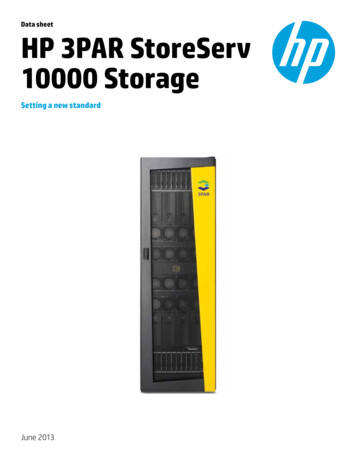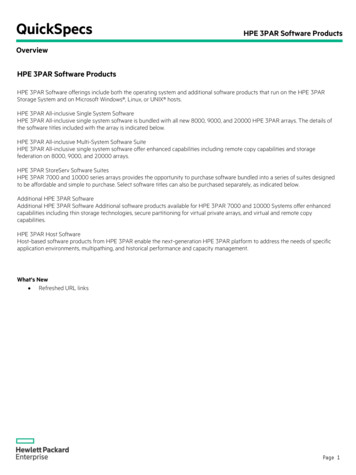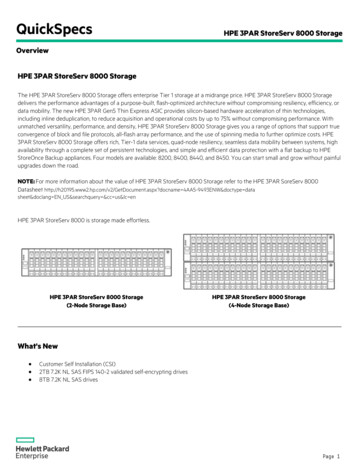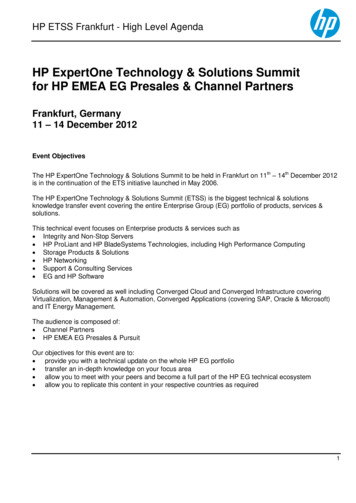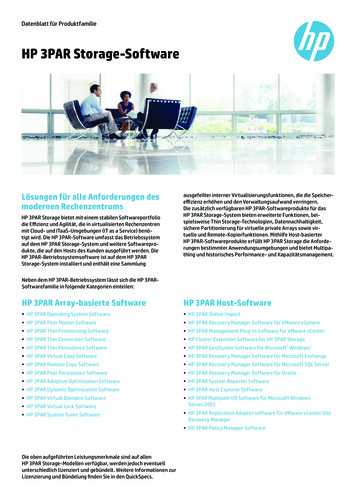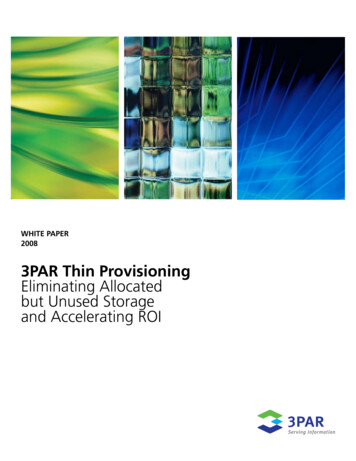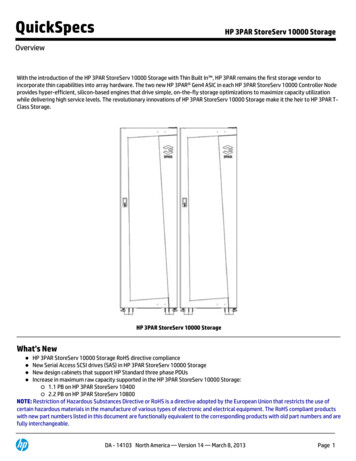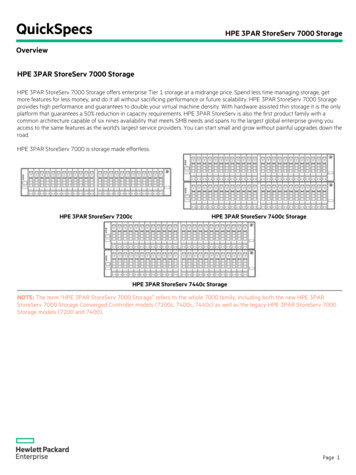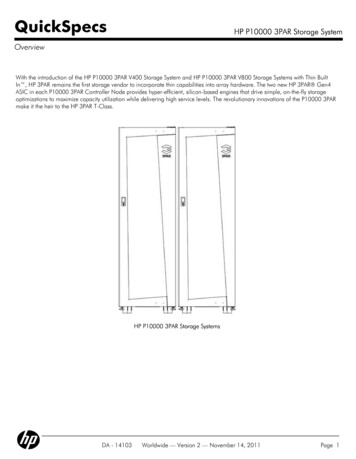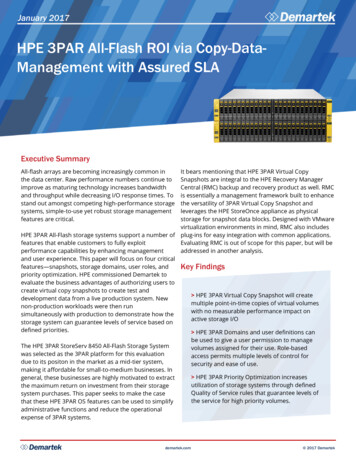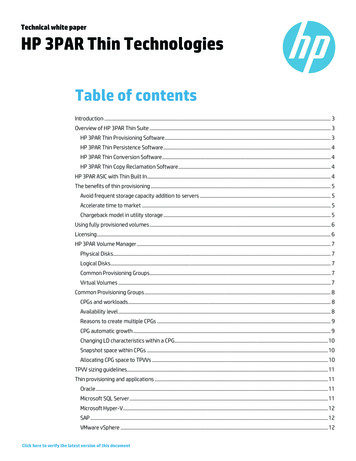
Transcription
Technical white paperHP 3PAR Thin TechnologiesTable of contentsIntroduction . 3Overview of HP 3PAR Thin Suite . 3HP 3PAR Thin Provisioning Software. 3HP 3PAR Thin Persistence Software . 4HP 3PAR Thin Conversion Software . 4HP 3PAR Thin Copy Reclamation Software . 4HP 3PAR ASIC with Thin Built In . 4The benefits of thin provisioning . 5Avoid frequent storage capacity addition to servers . 5Accelerate time to market . 5Chargeback model in utility storage . 5Using fully provisioned volumes . 6Licensing. 6HP 3PAR Volume Manager . 7Physical Disks. 7Logical Disks . 7Common Provisioning Groups. 7Virtual Volumes . 7Common Provisioning Groups . 8CPGs and workloads . 8Availability level . 8Reasons to create multiple CPGs . 9CPG automatic growth . 9Changing LD characteristics within a CPG . 10Snapshot space within CPGs . 10Allocating CPG space to TPVVs . 10TPVV sizing guidelines. 11Thin provisioning and applications . 11Oracle . 11Microsoft SQL Server . 11Microsoft Hyper-V . 12SAP . 12VMware vSphere . 12Click here to verify the latest version of this document
Technical white paper HP 3PAR Thin TechnologiesManaging thin storage . 13Allocation warnings . 13Allocation limits . 14Remaining physical capacity alerts . 15Remaining CPG free space alerts . 15View logged warning and limit alerts . 15User recommendations . 16Tracking volume space usage . 16TPVVs . 16CPGs . 17System space . 17Total used space . 18Running out of space . 19Running out of space in a TPVV . 19Running out of space in a CPG . 19Running out of space on the system . 19Usage reporting and trend analysis . 19Reclaiming Unused Space . 19Reclaiming Unmapped Logical Disk Space from CPGs . 20Automatically Reclaiming Unused Snapshot Space from Volumes . 20Deleted Volume Snapshot Space . 20Logical Disks and Chunklet Initialization . 20Free page consolidation . 20HP 3PAR Thin Persistence software . 21Thin persistence methods. 21Thin Reclamation for Microsoft Windows Server 2012 . 21Thin Reclamation for Microsoft Windows Server 2003 and 2008 . 22Thin Reclamation for VMware vSphere . 22Thin Reclamation for Linux . 23Thin Reclamation for UNIX . 24Thin Reclamation for Veritas Storage Foundation . 24Thin Reclamation for Oracle databases . 24Migration to thin-provisioned volumes . 26Migrate from full to thin provisioned volumes across arrays . 26Migrate between full and thin provisioned volumes on the same array . 26Conclusion . 27
Technical white paper HP 3PAR Thin TechnologiesIntroductionBalancing the storage needs of new projects or of unpredictable workloads against limited resources is the prime challengeof IT managers today. Of the many proposed solutions for improving storage efficiency, few are actually implemented.Of those implemented, fewer still achieve demonstrable success.Thin provisioning has achieved widespread adoption as it dramatically increases capacity efficiencies. It has become adata center “must have” for its ability to break the connection between logical and physical capacity. However, not allthin-provisioning implementations deliver the same results. Some are complex to deploy, while others use coarse allocationunits and cannot deliver the required space savings.Thin provisioning allows a volume to be created and made available as a logical unit number (LUN) to a host without theneed to dedicate physical storage until it is actually needed. HP 3PAR Thin Provisioning software has long been consideredthe gold standard in thin provisioning for its simplicity and efficiency. Unlike other “bolt-on” implementations, HP 3PAR ThinProvisioning software is simple and efficient, helps your organization start new projects more quickly and on demand andsave millions of dollars. HP 3PAR Thin Provisioning leverages the dedicate-on-write approach of HP 3PAR StoreServStorage, allowing enterprises like yours to purchase only the disk capacity they actually need. HP 3PAR Thin Provisioningintegrates seamlessly with VMware vSphere, Windows Server 2012, Red Hat Enterprise Linux, and Symantec VeritasStorage Foundation—greatly enhancing the operative and administrative efficiency of these platforms.While HP 3PAR Thin Provisioning software is extremely simple to deploy and use, a certain amount of planning isadvantageous to maximize its benefits. This paper documents best practices on thin provisioning on HP 3PAR StoreServStorage and is intended for administrators looking to get the most out of their HP 3PAR StoreServ deployment. In addition,it describes other HP 3PAR thin technologies that you can use in conjunction with HP 3PAR Thin Provisioning software tomaximize its effectiveness. Unique to HP 3PAR StoreServ, HP 3PAR Thin Conversion software enables you to reducecapacity requirements by 50 percent or more 1 by deploying HP 3PAR StoreServ in place of legacy storage.HP 3PAR Thin Persistence software and other thin-reclamation solutions enable thin-provisioned storage onHP 3PAR StoreServ arrays to stay thin over time by ensuring that unused capacity is reclaimed for use by the array on anongoing basis.Overview of HP 3PAR Thin SuiteHP 3PAR Thin Provisioning SoftwareHP 3PAR Thin Provisioning is the most comprehensive thin provisioning software solution available. Since its introduction in2002, HP 3PAR Thin Provisioning has been widely considered the gold standard in thin provisioning. It leverages HP 3PARStoreServ’s dedicate-on-write capabilities to make storage more efficient and more green, allowing customers to purchaseonly the disk capacity they actually need and only as they actually need it.With Thin Provisioning, there is no more up-front capacity allocation. No more dedicating resources for each application.No more paying to house, power, and cool disks that might not be needed for months or years to come, or may never beneeded at all.Product Highlights HP 3PAR Thin Provisioning is completely automated HP 3PAR Operating System uses a reservationless, dedicate-on-write approach to thin provisioning that draws andconfigures capacity in fine-grained increments from a single free space reservoir without pre-dedication of any kind. HP 3PAR Thin Provisioning uses an allocation unit size of just 16 KB, so you don’t have to worry about small writesconsuming megabytes or even gigabytes of capacity. HP 3PAR StoreServ is a storage platform built from the ground up to support thin provisioning by eliminating thediminished performance and functional limitations that plague bolt-on thin solutions.1Refer to the HP 3PAR Thin Guarantee for details: hp.com/storage/getthin.3
Technical white paper HP 3PAR Thin TechnologiesHP 3PAR Thin Persistence SoftwareHP 3PAR Thin Persistence software is an optional feature that keeps Thin Provisioned Virtual Volumes (TPVVs) andread/write snapshots of TPVVs small by detecting pages of zeros during data transfers and not allocating space for thezeros. This feature works in real-time and analyzes the data before it is written to the source TPVV or read/write snapshotof the TPVV. Freed blocks of 16 KB of contiguous space are returned to the source volume, freed blocks of 128 MB ofcontiguous space are returned to the CPG for use by other volumes. With HP 3PAR Thin Persistence, HP 3PAR StoreServStorage customers can now leverage next generation space reclamation technology to minimize storage TCO.HP 3PAR Thin Conversion SoftwareWith HP 3PAR Thin Conversion, a technology refresh no longer requires a terabyte-for-terabyte replacement, but insteadoffers the opportunity to eliminate up to 75% 2 of your legacy capacity, simply and rapidly. This savings alone can save youup to 60% on the cost of a technology refresh.With HP 3PAR Thin Conversion, you can quickly shrink your storage footprint, reduce storage TCO, and meet your Green ITtargets. HP 3PAR Thin Conversion software makes this possible by leveraging the zero-detection capabilities within theHP 3PAR ASIC and Thin Engine (a unique virtualization mapping engine for space reclamation) to power the simple and rapidconversion of inefficient, “fat” volumes on legacy arrays to more efficient, higher-utilization “thin” volumes. Getting thin hasnever been so easy.HP 3PAR Thin Conversion Software is an optional feature that converts a fully-provisioned volume to a Thinly-ProvisionedVirtual Volume (TPVV). Virtual volumes with large amounts of allocated but unused space are converted to TPVVs that aremuch smaller than the original volume. During the conversion process, allocated but unused space is discarded and theresult is a TPVV that uses less space than the original volume.HP 3PAR Thin Copy Reclamation SoftwareAn industry first, Thin Copy Reclamation keeps your storage as lean and efficient as possible by reclaiming unused spaceresulting from deleted virtual copy snapshots and remote copy volumes. Thin Copy Reclamation is built on a virtualizationmapping engine for space reclamation called HP 3PAR Thin Engine, which is included as part of the HP 3PAR OS. HP 3PARThin Copy Reclamation Software is an optional feature that reclaims space when snapshots are deleted from a system.As snapshots are deleted, the snapshot space is reclaimed from a Thinly-Provisioned Virtual Volume (TPVV) orfully-provisioned virtual volume and returned to the CPG for reuse by other volumes. Deleted snapshot space can bereclaimed from virtual copies, physical copies, or remote copies.HP 3PAR ASIC with Thin Built InAt the heart of every HP 3PAR StoreServ node there is a HP 3PAR ASIC with Thin Built In which features an efficient,silicon-based zero-detection mechanism. This unique hardware capability gives HP 3PAR StoreServ Storage the powerto remove allocated but unused space inline and non-disruptively without impacting performance.The zero detect capability will recognize an incoming write request of 16 KB of zeros and either not allocate space for thezero block or free the space if it was already allocated for that block. All this happens in cache and therefore no zeroes arewritten to the backend. When a read request comes in for a block that is unallocated the HP 3PAR StoreServ willimmediately return zeros back to the host.Many other storage arrays do not detect blocks of zeroes on write. Instead, the zeros are written to disk and a scrubbingprocess later detects these zeroed blocks and discards them. With this approach the zeroed blocks consume space untilthey’re scrubbed and therefore they may not be available for use by other volumes when needed. Also there is increasedload placed on the storage as the scrubbing process examines the block contents on the physical storage.The HP 3PAR StoreServ built-in zero detection capability can be controlled per virtual volume and it is enabled by default.24Based on documented client results that are subject to unique business conditions, client IT environment, HP products deployed, and other factors.These results may not be typical; your results may vary.
Technical white paper HP 3PAR Thin TechnologiesThe benefits of thin provisioningThin provisioning can be used with nearly all applications available in the market to improve storage utilization dramatically.The following use cases illustrate the superior value from thin provisioning on HP 3PAR StoreServ.Avoid frequent storage capacity addition to serversStorage administrators often allocate and present a large amount of storage to a server at the start of a project toaccommodate its long-term growth requirements. This practice reduces the number of times that LUNs mapped to theserver have to be expanded, an operation that can be complex, time consuming, and cause server downtime. With theHP 3PAR Thin Provisioning software, it is possible to allocate large amounts of storage to a particular server but onlyconsume physical space on the array as used. This fits environments where: The addition or expansion of storage provisioned to servers is not desired, for example in mission-critical environments. Relatively slow growth rates or unpredictable growth over time occurs. This can happen on large file systems used forgroup shares, mailbox databases, or general database space.Accelerate time to marketIn an application’s development stage, there is sometimes a requirement for the application storage to be in place andready before the application goes live. With the HP 3PAR Thin Provisioning software, it is possible to present the full amountof storage immediately so that it is ready for the developers to work on without the requirement for the full physicalcapacity being in place. Because thin provisioning gives storage administrators the ability to place limits on TPVVs and CPGs,the administrator can make sure that the developer’s work does not affect other production systems by using the freespace within the HP 3PAR StoreServ. After the application is ready to go live, these limits can be removed.Chargeback model in utility storageHP 3PAR Thin Provisioning is ideal for enterprise customers and service providers wishing to deploy a storage offeringwhere usage chargeback is an important component of the service. Thin provisioning offers these customers thefollowing benefits: Deploy quickly Decouple the charges for storage from the limitations of actual presented storage Remove the exposure to disruption of service during future capacity expansions Increase profit margins based on the savings resulting from the difference in cost for provisioned storage compared toactual physically used storage Collect detailed charging data at the individual VV level (usage shown by the showvv –p –prov [full cpvv tpvv snp] or atthe CPG level (usage shown by the showcpg –r cpg or showvv –p –cpg cpg )When planning to collect charging data, it is recommended that the names chosen for objects like CPGs, VVs, snapshots, anddomains contain a meaningful prefix or suffix referring to the project, application, line of business or department the objectsbelong to. This enables the grouping of objects in the chargeback report. The HP 3PAR OS allows up to 31 characters for thename of an object.5
Technical white paper HP 3PAR Thin TechnologiesUsing fully provisioned volumesThe use of thin provisioning has minimal performance impact and has the significant operational benefit of reducing storageconsumption. However, there are certain workloads and applications thin provisioning may not be of benefit such as: Systems with a high file system utilization. File systems on TPVVs that are nearly full offer reduced benefits of thinprovisioning. This relates to the fact that, for thin volumes, the thin-provisioning license charge is incurred in addition tothe cost for physical disk capacity used. In the case of file system utilization rates of 80 percent or higher, it may be morecost-efficient to use fat-provisioned volumes to hold the data. Applications that write continuously to new space. An example of this is Oracle redo log files. Databases not in “auto-extend” mode (or equivalent). Some databases initialize their assigned storage at creationtime by writing markers at regular intervals over the entire volume. This has the same effect as provisioning file systemswith a high utilization on thin volumes. Small capacity requirements. Thin provisioning is ideal for large-scale volumes. For small size VVs (256 MB up to a fewtens of GB) even the minimum growth increment of the CPG may mean that minimal benefit is realized. Use care in theselection of the CPG growth increment in this case. Environments that require host encrypted volumes. Writing blocks of zeros to a host encrypted volume on a newlycreated HP 3PAR StoreServ thin-provisioned volume will cause space to be allocated on the TPVV because the encryptionalters the content of the blocks. Applying encryption to thin-provisioned volumes that already contain data or rekeyingthem also inflates the zero blocks, making the volume consume space as if it was fully provisioned. Attempting to rethinthe volume by writing zeros to allocated but unused space is not possible as well. As a result, host encryption and thinprovisioning do not cooperate well. Environments that require SAN encrypted volumes. Like host based encryption, encryption by a device in the data path(e.g. SAN switch) will also alter the data stream so that blocks of zeros written by the host are not passed onto the storage.A notable exception is Brocade SAN switches. With the introduction of Fabric OS 7.1.0, the Fabric OS encryption switch canautomatically detect if a disk LUN is a thin provisioned LUN. If a LUN is detected as being thin provisioned, then first-timeencryption and rekey are done on the allocated blocks only. This thin provision LUN support requires no action by the user. Copy-on-Write file systems. File systems that write to new blocks rather than overwrite existing data are not suitablefor thin provisioning as every write will allocate new storage until the volume is fully allocated. An example of a CoW filesystem is Solaris ZFS.LicensingThe HP 3PAR Thin Provisioning software license is needed to create TPVVs. Thin provisioning is licensed based on the numberof terabytes of raw capacity written to thin provisioned volumes. Space used by snapshots is also included in this figure.Because of the “raw capacity written” metric, no fraction of the license is consumed by creating thin provisioned volumes andnot writing to them. The rate of consumption of a thin provisioning license will depend on the RAID level of the TPVVs. Assumethe array has a thin provisioning license for 1 TB and a 500 GB TPVV in a RAID 1 was created. When the user writes 300 GB ofdata to it, the thin provisioning license is consumed for 300 GB * 2 600 GB. The multiplier of 2 originates from the RAID 1overhead factor. If the TPVV was created in RAID 5 (3D 1P), 300 * 4/3 400 GB of space would have been consumed from thethin provisioning license.When doing a remote copy of a thin volume, the destination array needs a thin provisioning license as well. Otherwise thecopy of a TPVV volume on the source array will create a full provisioned volume at the target.The HP 3PAR Thin Conversion software, HP 3PAR Thin Persistence software and HP 3PAR Thin Copy Reclamation softwarealso require licenses. The functionality offered by each license is summarized in table 1.Table 1. Summary of the thin storage technology licensesLicenseFunctionalityThin ProvisioningThe creation of Thinly-Provisioned Virtual VolumesThin PersistenceZero detection to free previously allocated spaceThin ConversionZero detection to prevent allocation of space and enables UNMAP supportThin Copy ReclamationReclaiming unused space resulting from deleted virtual copy snapshots and remote copy volumesFor the HP 3PAR StoreServ 7000, 7450, and 10000, the licenses for HP 3PAR Thin Provisioning, Thin Conversion, ThinPersistence, and HP 3PAR Thin Copy Reclamation are included in the HP 3PAR Operating System Software Suite.6
Technical white paper HP 3PAR Thin TechnologiesHP 3PAR Volume ManagerThe HP 3PAR Operating System has a logical volume manager that provides the virtual volume abstraction. It is comprisedof several layers with each layer being created from elements of the layer below.Physical DisksEvery physical disk (PD) that is admitted into the system is divided into 1 GB 3 chunklets. A chunklet is the most basicelement of data storage of the HP 3PAR OS. These chunklets form the basis of the RAID sets, depending on the sparingalgorithm and system configuration some chunklets are allocated as spares.Logical DisksThe logical disk (LD) layer is where the RAID functionality occurs. Multiple chunklet RAID sets, typically from different PDs,are striped together to form a LD. All chunklets belonging to a given LD will be from the same drive type. LDs can consist ofall NL, FC, or SSD chunklets. There are no mixed type LDs with the exception of Fast Class (Fibre Channel or SAS) where anLD may consist of mixed 10K and 15K drive chunklets.There are three types of logical disk:1.2.3.User (USR) logical disks provide user storage space to fully provisioned virtual volumes.Snapshot data (SD) logical disks provide the storage space for s
HP 3PAR Thin Technologies . . HP 3PAR StoreServ is a storage platform built from the ground up to support thin provisioning by eliminating the diminished performance and functional limitations that plague bolt-on thin solutions. 1 Refer to the HP 3PAR Thin Guarantee for details:
